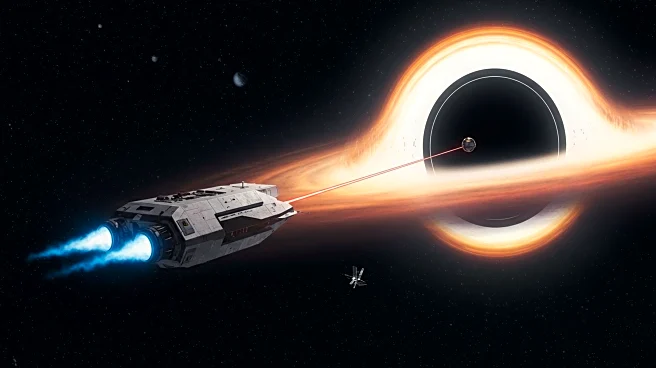What's Happening?
Astrophysicist Cosimo Bambi has proposed an ambitious mission to send a gram-scale probe to a black hole located 20 light-years away. The mission aims to test the foundations of physics and general relativity, potentially opening new frontiers in space exploration. The probe, equipped with a microchip and a light sail, would be accelerated by powerful lasers to reach its destination within 70 years. Despite the promise of groundbreaking scientific discoveries, the mission faces significant technological and financial challenges. The estimated cost of the lasers required for propulsion is around one trillion euros, but advancements in technology could reduce costs to about one billion euros. The mission's feasibility also depends on locating a nearby black hole, which is challenging due to their lack of light emission.
Why It's Important?
This mission could revolutionize our understanding of black holes and general relativity by providing direct measurements and experiments in a pristine environment. Current ground-based instruments are limited by complex theoretical models, which often struggle with the 'unclean' environments around black holes. A successful mission could confirm whether black holes possess an event horizon and test Einstein's theory under extreme cosmic conditions. The proposal highlights the relentless pursuit of knowledge in the scientific community and underscores the potential for technological advancements to make seemingly impossible missions feasible. International collaboration could play a crucial role in overcoming financial and technical challenges, transforming the mission from a conceptual proposal into a landmark achievement in space exploration.
What's Next?
The mission's success hinges on overcoming technological limitations and financial costs. As technology advances, the mission could be funded at a cost comparable to large-scale space missions today. The durability of the nanocraft is also a critical factor, as it must withstand a decades-long voyage through interstellar space. Bambi draws parallels to Voyager 1, which remains operational decades after its launch, suggesting that long-term space missions are possible. The scientific community is expected to engage in dialogue about the mission's feasibility and potential impact, with international collaboration being a key factor in its realization.
Beyond the Headlines
The mission raises important questions about the future of space exploration, including how to balance the quest for knowledge with practical challenges of technology and finance. It invites consideration of the role of international collaboration in overcoming barriers and the responsibilities that come with pursuing understanding of the universe's most enigmatic entities. The proposal serves as a reminder of the potential for technological progress to outpace expectations, making today's dreams tomorrow's reality.












